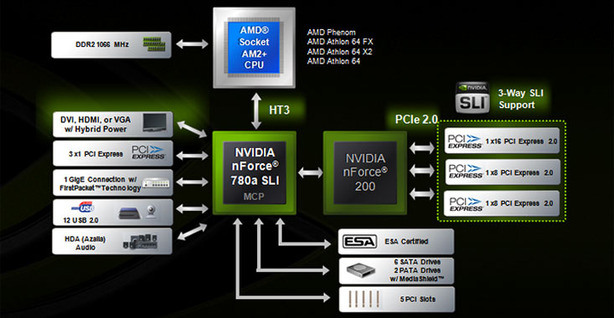
nForce 700a series
So far, Hybrid SLI looks pretty appealing, but it is not without its downsides. While talking about the technology on paper is cool, its implementation relies on solid hardware to back it up. In this case, Nvidia is introducing it with the nForce 700a series of motherboards.The range covers price points from £150+, right the way down to around £50 (all including VAT) and your requirements will pretty much dictate which of the chipsets you’re going to buy. For example, the nForce 780a SLI is the only 700a series chipset that supports 3-way SLI, ESA and SLI-ready memory and is the only choice if you want to make use of any of those features.
nForce 780a SLI supports both HybridPower and GeForce Boost as well, which means you can make use of all the technology we’ve talked about in this article, providing you’ve got at least one GPU that supports one or other of the technologies – it’s unlikely that you’ll see a graphics card that supports both technologies in the near future.
Along with the MCP72XE chipset, Nvidia uses the nForce 200 chip in order to enable support for 3-way SLI on nForce 780a SLI boards. When Nvidia first talked about this chip when it introduced the nForce 780i SLI chipset, it gave very little information on what it did – the reason being that some of the patented technology inside it hadn’t been approved.
With nForce 200, Nvidia has basically created an SLI chip in and of itself that implements some very cool technology to help remove some of the bottlenecks that can exist when you’re scaling to more than two GPUs. With nForce 780i SLI, the so-called bridge chip was connected via PCI-Express 1.1 and many complained that it was going to suffer from a serious lack of bandwidth. nForce 780a SLI uses a PCI-Express 2.0 x16 interconnect that will deliver twice as much bandwidth but, to be honest, there’s no need for any more than an x16 PCI-Express 1.1 interconnect.
The reason for this is twofold – first, there is a CPU Broadcast controller in nForce 200 which basically means that the CPU only needs to issue one write command to an array of GPUs connected together in SLI. The CPU Broadcast controller then sends the write command out to all of the GPUs that are in the SLI configuration. This means there is only one lot of traffic passing between the CPU and the PCI-Express controller – if you’re using three GPUs in SLI (or even four, hypothetically speaking), that’s a massive amount of bandwidth saved.
Secondly, there is a PW Shortcut, which basically provides a fast point-to-point write capability that allows write commands to travel between any pair of GPUs. Again, like the multiple write command broadcasts, this used to have to travel via the CPU and resulted in increased CPU and bus bottlenecks when you really started to scale the number of GPUs.

Nvidia's nForce 780a SLI chipset -- block diagram
Of course, not everyone wants features like 3-way SLI, ESA and SLI-ready memory and Nvidia recognises this. As a result there is a more cost effective SLI solution available called nForce 750a SLI. This still supports both HybridPower and GeForce Boost, along with 2-way SLI. In this case, the implementation is two x8 PCI-Express 2.0 slots and it’s a single chip solution unlike the nForce 780a SLI chipset, which needs the nForce 200 chip to enable 3-way SLI support.
| Nvidia Hybrid SLI Ready AMD Platforms | |||||
| Nvidia chipset | Target Market | Form Factor | HybridPower | GeForce Boost | Other Features |
| nForce 780a SLI | Enthusiast (£150+) | ATX | Yes | Yes | 3-way SLI, ESA, SLI-ready memory |
| nForce 750a SLI | Performance Gamer (£75) | ATX | Yes | Yes | 2-way SLI |
| nForce 730a | Mainstream Gamer (£50) | ATX | No | Yes | 1 x16 PCI-Express 2.0 |
| GeForce 8200 | Mainstream (Vista Premium, HTPC, etc) | mATX | Yes | Yes | 1 x16 PCI-Express 2.0 |
Further down the line, there is the nForce 730a – this is targeted at mainstream gamers and, according to Nvidia, boards will cost around £50 (inc. VAT). There could be some pretty good cost-effective boards here providing Nvidia doesn’t intentionally cripple overclocking on this chipset. Sadly, there is no support for HybridPower, but there is support for GeForce Boost. The former is a little disappointing, because it throws out the idea of getting a cheap board with just a single PCI-Express x16 slot and then spending more on a faster graphics card.
When I asked Nvidia why this was the case, I was told that it was a cost saving decision that needed to be made in order to keep the cost of manufacturing down because HybridPower requires additional circuitry. What’s strange though is that Nvidia includes support for HybridPower on the GeForce 8200 motherboards, which are probably going to cost about the same – if not less in some cases.

MSI MPG Velox 100R Chassis Review
October 14 2021 | 15:04










Want to comment? Please log in.